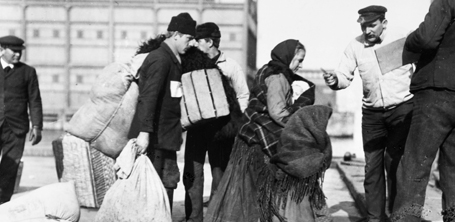

The 20th century began with the assassination of President William McKinley in 1901. The Vice President, Theodore Roosevelt, was quickly sworn in as president and started a progressive administration that changed the United States at a crucial time in history.
This period from about 1900 to 1917 is known as the Progressive Era because of political, economic, and social reforms. The reformers, called Progressives, wanted to end corruption in government, make government more responsible for the needs of the common people, and curb the powers of giant business corporations.
The Progressives were also disturbed by the vast increase in immigration, mainly from eastern and southern Europe, and by the growing social problems of the cities. Another change in the American landscape was the migration of African Americans from the rural South to Northern cities. To learn more about immigration and to take an interactive tour of Ellis Island, click here.
President Teddy Roosevelt's foreign policy was guided by the belief that the United States must police the Western Hemisphere and should accept the responsibilities of a world power. This policy changed in 1912, when Woodrow Wilson, then governor of New Jersey, won the presidential election.
Soon after taking office, Wilson was faced with a huge war in Europe. World War I broke out in Europe in 1914. The main participants were Britain, France, and Russia, known as the Allies; and Germany and the Austro-Hungarian Empire, called the Central Powers.
Wilson wanted to keep the United States neutral in the conflict, but it was not easy. On one hand, the Britain used its powerful navy to cut off supplies to the Central Powers. Germany retaliated by the use of submarine warfare against British shipping and countries trading with the Allies — including the United States. In 1915 a British ocean liner called the Lusitania was sunk by a German submarine. The attack killed124 Americans, and the American public was outraged.
Wilson put pressure on Germany to end unrestricted submarine warfare. This was successful for a few years. When Germany resumed sinking all ships in European waters, Wilson felt that he had no choice but to ask Congress in 1917 for a declaration of war. Two million Americans went to Europe in aid of the Allies to help them win World War I in 1918.
Back in the United States, Wilson was facing unrest from another front — women. Since the middle of the 1800s, women had been asking for the right to vote. This voice got stronger through the years.
By 1900, there were some victories in the women’s rights movement. Women could vote in four states — Colorado, Idaho, Utah, and Wyoming. They could attend high schools and colleges, had property rights in many states, and more women found jobs outside the home.
When the United States entered World War I, w0omen served as nurses on the battlefields and performed the work at home the soldiers left behind. Just 41 days before the war ended in 1918, President Woodrow Wilson urged the Senate to pass the women's suffrage amendment. "We have made partners of the women in this war," he declared. "Shall we admit them only to a partnership of suffering and sacrifice and toil and not to a partnership of privilege and right?"
On May 21, 1919, the House of Representatives passed the 19th Amendment, followed by the Senate on June 4, 1919. When it was ratified by the required number of states on August 26, 1920, women were finally legally guaranteed the right to vote.
Read the diaries of Margaret Ann Brady, a girl who takes a tragic voyage across the ocean to meet her brother in America; Lydia Amelia Pierce, an orphan who goes to live with the Shakers; Nellie Lee Love, an African-American girl who moves to Chicago with her family; Zipporah Feldman, a Jewish immigrant making her way in New York City; Kathleen Bowen, a girl who watches her mother fight for women’s rights; and Simone Spencer, a girl who watches her brother go off to war and follows to become a telephone operator on the battlefield. Each of these girls lives in the same time but their lives are vastly different.

